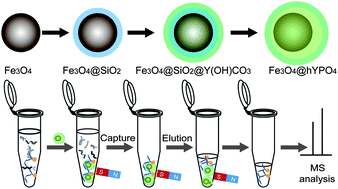Yolk–shell magnetic microspheres with mesoporous yttrium phosphate shells for selective capture and identification of phosphopeptides†
Abstract
Architectural design is important to achieve appropriate chemical and biological properties of nanostructures. Yolk–shell magnetic microspheres consisting of Fe3O4 cores and porous and hollow YPO4 affinity shells have been designed and constructed. The yolk–shell magnetic microspheres have a saturation magnetization (Ms) value of 48.3 emu g−1 with a negligible coercivity and remanence at 300 K and a BET specific surface area of 12.5 m2 g−1 with an average pore size of 10.1 nm for the mesoporous YPO4 shell. The novel multifunctional yolk–shell nanostructures can realize the selective capture, convenient magnetic separation and rapid identification of target phosphopeptides by taking advantage of the Fe3O4 magnetic cores and the selective YPO4 affinity shells. Sensitivity and selectivity of the affinity yolk–shell nanostructures were evaluated by digests of standard proteins and complex biosamples. 2678 unique phosphopeptides were captured and identified from the digest of mouse brain proteins. Therefore, this work will be highly beneficial for future applications in the isolation and purification of biomolecules, in particular, low-abundance phosphopeptide biomarkers.


 Please wait while we load your content...
Please wait while we load your content...